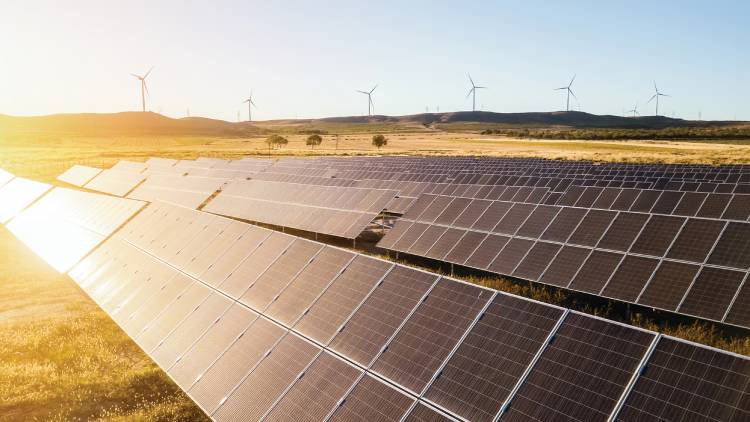Fraud protection.
Now it's personal.
ANZ Falcon® technology monitors millions of transactions every day to help keep you safe from fraud.
Falcon® is a registered trademark of Fair Issac Corporation.
To meet the Paris Agreement goals, significant greenhouse gas emissions reductions are required across all sectors of the economy. Trillions of dollars are needed to invest in new and existing technologies that help reduce emissions.
We expect that the many financing opportunities, linked to our business strategy, will contribute to achieving the Paris Agreement goals and the transition to a net-zero economy. The opportunities will also deliver appropriate returns for our shareholders.
ANZ’s ambition is to transition its lending portfolio to net zero financed emissions by 2050 in line with the goals of the Paris Agreement.
We support an effective and orderly transition that recognises and responds to social, economic and environmental impacts of a net-zero transition. This aligns with our purpose to shape a world in which people and communities thrive.

By anticipating changes to financial markets and financial systems, we seek to better identify and manage climate risks and opportunities.
These changes include:
We are responding to these changes and have identified opportunities in four key areas:
The most important role we can play in the transition to net-zero is to support our customers to reduce emissions and to adapt and become more resilient to a changing environment and economy.
Our success in supporting and accelerating a net zero transition by 2050 will be driven by our ability to help our customers reduce their emissions.
We recognise it is vital to work collaboratively with our stakeholders to help support the transition to net-zero emissions.
We are reducing our operations’ greenhouse gas emissions to manage our climate impact.

For a summary of our climate change approach and opportunities we have identified in key areas, please refer to our ANZ Climate Change Commitment (PDF 95KB). Additional disclosures and policies can also be found at ESG reporting.
We provide investors and other stakeholders with clear information enabling them to assess the adequacy of our approach to climate change and our ability to manage the associated risks and opportunities.
We report using the recommendations of the Financial Stability Board Task Force on Climate-related Financial Disclosures (TCFD).


This report provides stakeholders with detailed information on ANZ’s ESG performance and challenges. It includes performance against our ESG targets and our management of material ESG issues.
This report provides stakeholders with detailed information on ANZ’s ESG performance and challenges. It includes performance against our ESG targets and our management of material ESG issues. Released 10 November 2025.
ANZ's Social and Environmental Sustainability Target Methodology. Updated 8 November 2024.
The 2025 Annual GHG Emissions and Carbon Offset Data Assurance Statement details our global carbon offset data, prepared by KPMG. Released 10 November 2025.
Our 2025 Climate Report outlines ANZ's approach and progress towards our Climate and Environment Strategy’s vision to finance a sustainable transition. Released 10 November 2025.
Transitioning our lending portfolio to net zero financed emissions by 2050 in line with the goals of the Paris Agreement: Our approach to Institutional energy customers. Released 10 November 2025.
ESG and climate content disclosed in ANZ's full-year Investor Discussion Pack. Released 10 November 2025.
1. Refer to ANZ’s Social and Environmental Sustainability Target Methodology available at anz.com/esgreport
2. Our targets are in the metrics and targets section of our 2025 Climate Report, available at anz.com/esgreport That report also contains important notices about forward-looking statements and about the uncertainties, challenges and risks associated with climate-related information.
3. The energy sector includes integrated oil and gas companies involved in exploration, development and refining as well as low carbon energy solutions, thermal coal mining, and integrated power utility companies such as renewable energy and coal.
4. Energy use includes transport in addition to the power generation sector. The percentage of global emissions from energy use is sourced from the International Energy Agency (IEA), Net Zero by 2050: A Roadmap for the Global Energy Sector, October 2021.
5. Institutional, including Corporate, customers.
6. Our lending is informed by our evolving social, environmental and credit policies, which includes commitments relating to thermal coal. Information on our policies is available here: https://www.anz.com.au/about-us/esg/policies-practices/social-and-environmental-risk-management/
7. These include energy industry, extractive industry, land and forest management, water management and military equipment.
8. This includes an avenue for complaints that is available to stakeholders who have concerns about whether our business lending is consistent with our climate statement. Complaints can be made by contacting the Group General Manager, ESG or Chief Risk Officer.